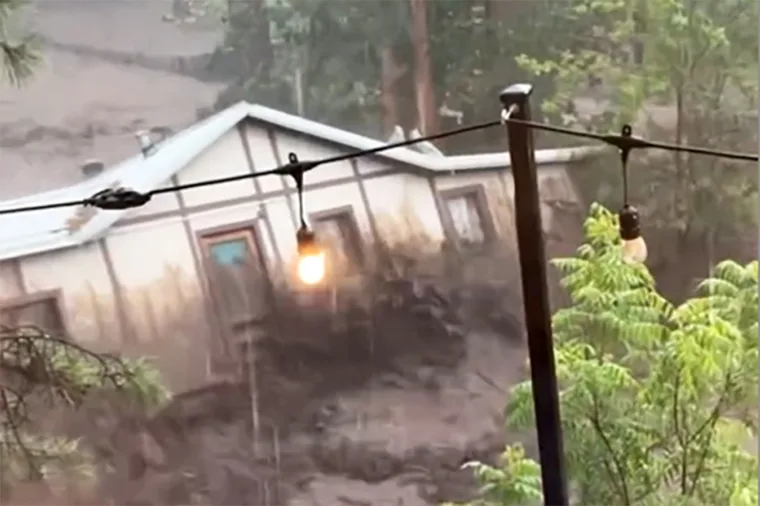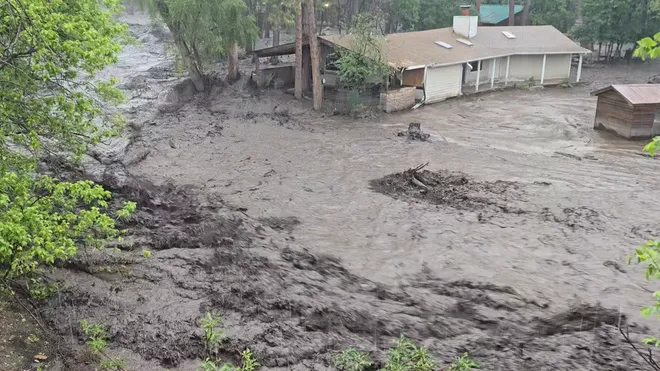RUIDOSO, NM — A catastrophic flash flood emergency has engulfed the village of Ruidoso, New Mexico, as powerful storms delivered torrents of rain to an already vulnerable landscape still recovering from the recent South Fork wildfire. Ruidoso flood with rain falling at dangerous rates—between 1.5 to 2.5 inches in just minutes—the floodwaters surged rapidly across the region, causing widespread destruction, home evacuations, and life-threatening conditions.
The National Weather Service (NWS) issued an urgent flash flood warning as early as Tuesday afternoon, and the situation quickly escalated into a crisis. Especially hard hit were areas surrounding burn scars—land left barren and hydrologically unstable by the recent wildfire. These zones proved defenseless against the downpour, transforming into channels of fast-moving water and debris.
“A dangerous situation is unfolding in Ruidoso. Seek higher ground now. Do not attempt to drive through the floodwaters,” warned the NWS Albuquerque office, echoing its stark advisory across all channels.

Ruidoso flood – Homes Swallowed, Roads Washed Out
Numerous homes across Ruidoso were quickly overtaken by floodwaters, forcing residents to flee with little or no warning. Emergency water rescues were launched throughout the village as entire neighborhoods became inaccessible. The typically tranquil Rio Ruidoso swelled to a staggering 15 feet—well above flood stage—engulfing streets and tearing away at riverbanks with powerful force.
One of the most visibly affected areas was the Hollywood neighborhood, where the powerful water currents carved through the terrain, dragging trees, rocks, and debris. Visuals shared by the NWS on social media depicted the alarming transformation of the gentle river into a destructive torrent.
Senator Martin Heinrich issued a personal plea to Ruidoso residents: “Evacuate immediately to higher ground. This is a life-threatening emergency.”

Burn Scars Amplify the Disaster
Ruidoso flood – The South Fork fire left the region with significant burn scars—areas stripped of trees and vegetation. These zones, now unable to absorb water, have become prime conditions for rapid runoff and deadly debris flows. As rain hits the scorched earth, it transforms the water into a thick, fast-moving slurry of ash, mud, and debris, which can destroy homes, roads, and even bridges.
This phenomenon turned what would otherwise be manageable rainfall into a catastrophic event. Emergency responders on the ground have had to work cautiously through treacherous terrain, knowing that conditions can change without warning due to the unstable slopes and debris-laden water.
Infrastructure, Community Heavily Affected
Kerry Gladden, a public information officer for the Village of Ruidoso, described how quickly the flooding peaked during a 20–30-minute window. Several key roads—including Mechem Drive at Sudderth and the Brady Canyon area—were closed due to impassable conditions. As the Ruidoso flood waters began to recede, crews moved quickly to remove debris and restore access to affected roads.
While much of the floodwater has since receded, it did reach the Ruidoso Downs racetrack, though mitigation efforts prevented any major damage. Officials confirmed that two vehicles were caught in the floods, one unoccupied and the other safely evacuated by firefighters.
Still, the toll is significant. Numerous homes that were already damaged by the wildfire have now suffered further destruction or structural weakening from the floodwaters. Residents, only just beginning to rebuild their lives after the wildfire, are once again displaced—grappling with financial and emotional devastation.
The Threat Is Not Over
Even as skies clear, the danger remains. Saturated ground and altered landscapes mean that even minor additional rainfall could trigger renewed flooding or mudslides. The NWS warns that another half inch of rain could fall by evening, possibly worsening the situation.
Looking Ahead: Recovery and Resilience
Ruidoso now faces the daunting task of recovering from a double blow—wildfire and flood. This recovery won’t just be about rebuilding homes and roads, but also developing long-term strategies to manage a landscape increasingly shaped by climate extremes. This includes revegetation, engineered drainage systems, and updated emergency preparedness plans.
As New Mexico continues to experience the growing impacts of climate variability, events like these may become more frequent. For now, the focus remains on immediate safety and support for those affected.
Stay connected with UState Pulse.